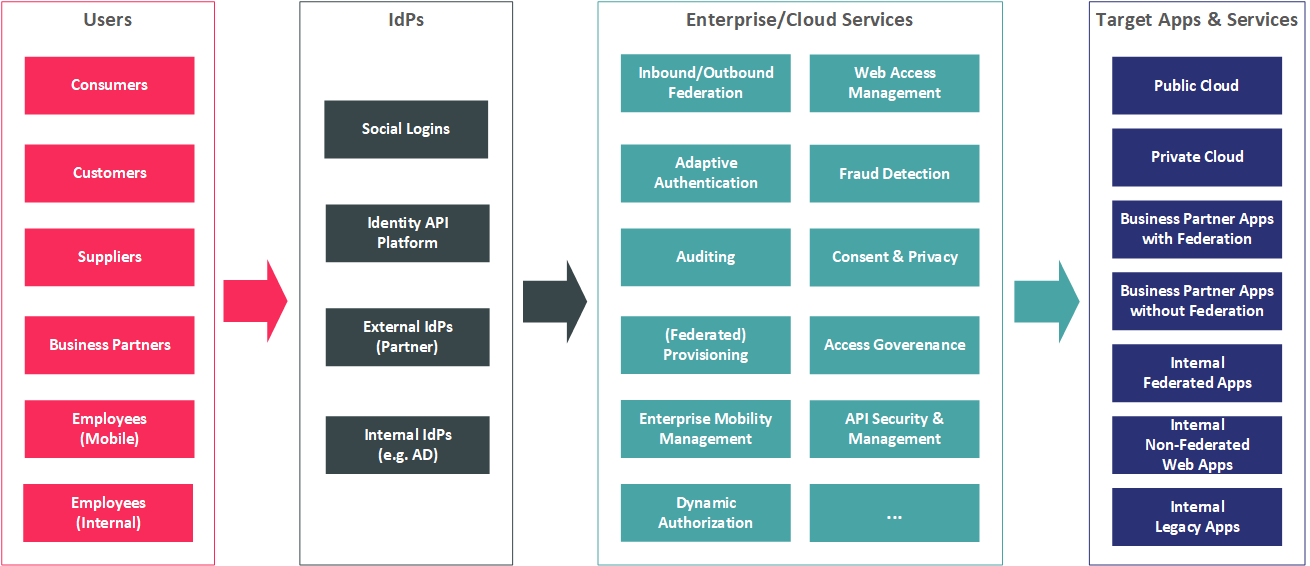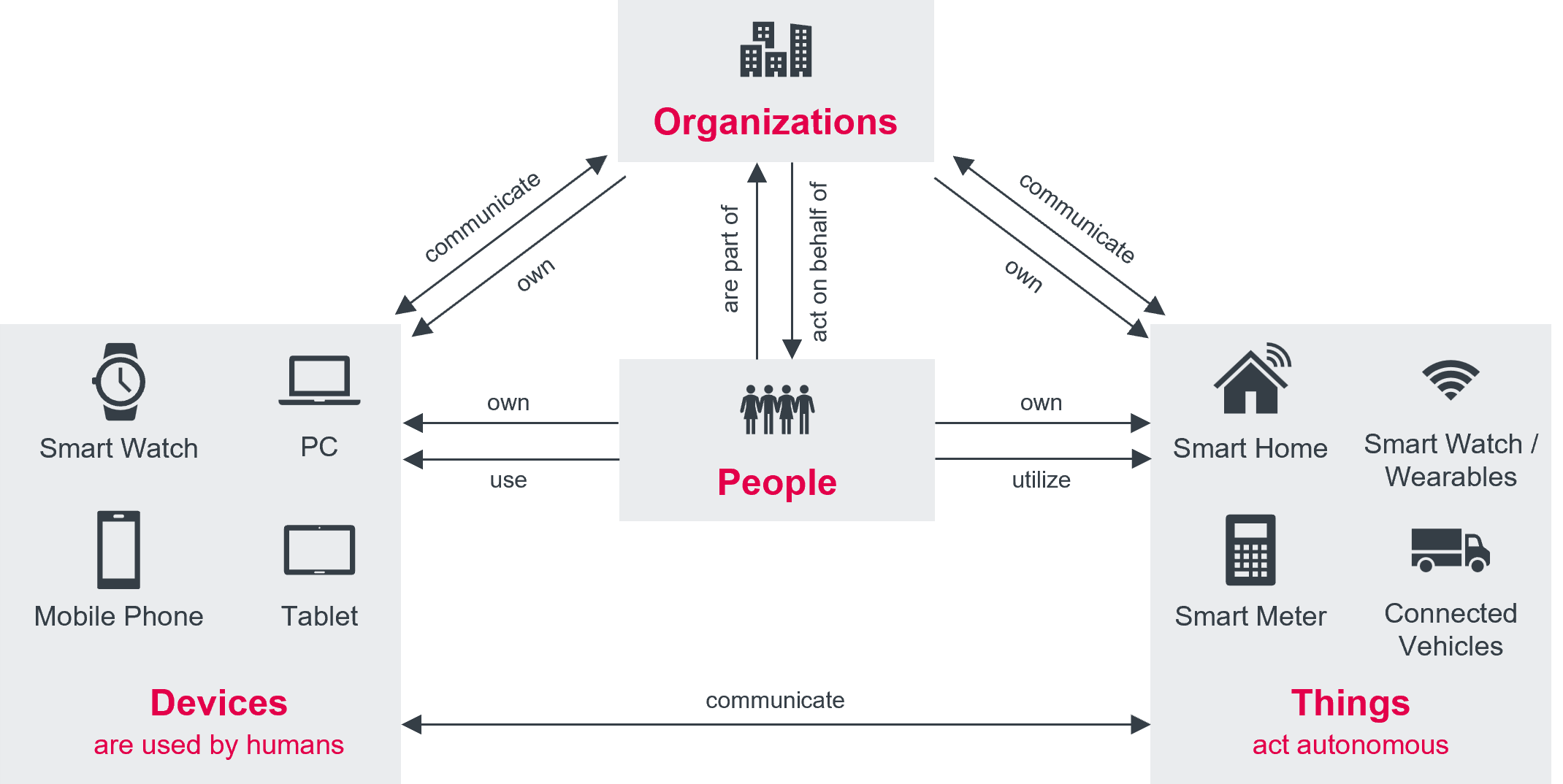1 Introduction / Executive Summary
Access Management refers to the group of capabilities targeted at supporting an organizations' access management requirements traditionally found within Web Access Management & Identity Federation solutions, such as Authentication, Authorization, Single Sign-On, Identity Federation.
These access management capabilities are well-established areas in IAM's broader scope (Identity and Access Management). They are continuing to gain attraction due to emerging requirements for integrating business partners and customers.
Web Access Management (WAM) & Identity Federation started as distinct offerings. (Web) Access Management is a traditional approach that puts a layer in front of web applications that takes over authentication and – usually coarse-grained – authorization management. Also, tools increasingly support APIs for authorization calls to the system. Identity Federation, on the other hand, allows splitting authentication and authorization between an IdP (Identity Provider) and a Service Provider (SP) or Relying Party (RP). Although Identity Federation can be used in various configurations, most vendors today provide integrated solutions that support centralized access management based on federation protocols such as SAML v2, OAuth, and OIDC.
Over the years, vendors have made significant changes to their product architecture to make them cloud-ready while extending to on-premises applications. These methods include delivering a single sign-on (SSO) experience to users across multiple web sites and allow for centralized user management, authentication, and access control.
These technologies are enabling technologies for business requirements such as agility, compliance, innovation (for instance, by allowing new forms of collaboration in industry networks or by adding more flexibility in the R & D supply chain), and the underlying partnership & communication.

Although traditional on-premises Access Management solutions have focused on WAM & Identity Federation solutions in the past, KuppingerCole sees a convergence of this market with Access Management focused IDaaS solutions. Therefore, this Leadership Compass considers Access Management solutions deployed on-premises, in the cloud, or as a hybrid model. Solutions offered as a managed service are also be considered when the technology is owned by the MSP (Managed Service Provider).
1.1 Market Segment
Access Management and Identity Federation should not be seen as separate segments in the IT market, but rather these technologies are inseparable. The business challenge is to support the increasingly growing "Connected and Intelligent Enterprise." Businesses require support for both external partners and customers. They need access to external systems, rapid onboarding, and request for access to external services such as Cloud services. Mobile devices are needed for organizations to support their workforce's desires to work anywhere from any device. These are only a few of the challenges organizations must face today.

The Access Management market provides a number of options to organizations. In the IDaaS market, with its ease of adoption and cloud-native integrations, is slowly overtaking the on-premises IAM market. At the same time, the IDaaS market continues to evolve. As an alternative to organizations managing the Access Management solutions themselves, some vendors provide offerings described as Managed Services, whether on-premises or Software as a Service (SaaS) offerings. There’s a varying level of support available from Access Management vendors to manage CIAM functions that support requirements for managing and complying with data sharing and privacy regulations, such as consumer notification and consent management.
The support for open identity standards continues to shape the direction of Access Management implementations. Some of the most popular authentication and identity federation standards include support for LDAP, Kerberos, OpenID, OAuth, SAML, and RADIUS. Organizations with a need for dynamic authorization management might require support for XACML or UMA. User provisioning services commonly require support for SCIM. And having access to the Access Management solution's functionality via APIs or other programmable interfaces will go a long way in keeping your IAM flexible and sustainable. API-based platforms typically require a developer-ready solution, providing API toolkits such as widgets or SDKs that facilitate rapid development.
Access Management continues to evolve beyond the traditional capabilities seen in the past. Increasingly, we see Access Management solutions providing security for APIs becoming more readily available and driven by the need to meet emerging IT requirements that include hybrid environments that span across on-premises, the cloud, and even multi-cloud environments. And although Fraud Detection solutions, also referred to as Fraud Reduction Intelligence Platforms (FIPS), is often considered a different market with their separate offerings, there has been a noticeable up-tick in Access Management solutions providing some level of Fraud Detection capabilities ranging from the detection of identity fraud through Identity Proofing to the detection of unauthorized account takeover, response mechanisms, or support for user and device profiling as some examples. More recently, there has been some indication and interest of Access Management support for Verifiable Credentials. This Leadership Compass evaluates and reports on the level of Fraud Detection, and Verifiable Credentials support for each vendor, giving the reader an indication of the extent of this trend in the Access Management market.
Besides these technical capabilities, we also evaluate participating Access Management vendors on the breadth of supported capabilities, operational requirements such as support for high availability and disaster recovery, strategic focus, partner ecosystem, quality of technical support, and the strength of market understanding and product roadmap. Another area of emphasis is providing Access Management capabilities out-of-the-box, rather than delivering functionality partially through 3rd party products or services. Finally, we also assess their ability to deliver a reliable and scalable Access Management service with desired security, UX, and TCO benefits.




































